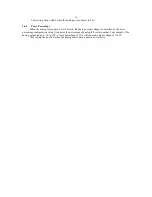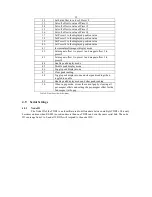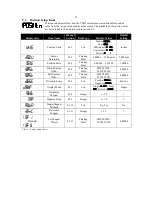
15
14
Magnet 14
15
Magnet 15
4.4.4
Digital Output Active Flag
Each digital output can be configured to be active when the position is inside the bounds or outside
the bounds. If the active flag is set to ‘INSIDE’, the output will be active when positions are inside the
bounds. If the active flag is set to ‘OUTSIDE’, the output will be active when positions are outside the
bounds.
4.5
Presets
Four Preset registers are provided, that can be accessed by special functions of the TDD2 display.
Each preset is a floating point value with units. The Preset registers can be loaded or read depending on the
action. Internal functions can perform math on the presets or use the presets as inputs to mathematical
functions. See sections 4.7 and 4.8 for more information.
4.6
Analog Output Settings
The analog output of the TDD2 can be configured to follow the velocity or position. It can also be
forced to a desired level. Analog options are only available on TDD2 models containing analog output
hardware.
4.6.1
Voltage Range
The TDD2 can be set to output analog voltages in several ranges: 0 to 5V, 0 to 10V, -5 to 5V, -10
to 10V, -2.5 to 2.5V, and -2.5 to 7V. The default range is 0 to 10V.
4.6.2
Analog Source Data
The analog output subsystem can be controlled by several sources of data. The output can be
forced to a certain level, the output can be based on the current displayed position, or the output can be
based on the current velocity.
When position is used as the source data, the analog output voltage will be based on the displayed
position within a range (see section 4.6.4), beginning at the analog start position (see section 4.6.3).
If the analog source data is velocity, the output voltage is 50% of maximum when the velocity is 0
units/second. The output voltage will be at maximum when the velocity is equal to the analog range (see
section 4.6.4), and the voltage will be at the minimum then the velocity equal to minus analog range.
4.6.3
Analog Start
When the analog output is controlled by position information, this value is the position where
analog voltage will be the minimum. Any position smaller than this value will also result in minimum
analog voltage.
When the analog output is controlled by velocity information, this value is the velocity where
analog voltage will be at the midpoint between the minimum and maximum.
This setting has no effect when the analog source is forced.
4.6.4
Analog Ran
g
e
The analog range controls the range the analog output spans. It is valid when the analog output
data source is position or velocity, although the meaning is slightly different.
When the analog source data is position, the analog range is the number of units between the
analog start and the position causing maximum analog output. For example, if the analog output voltage
range is 0-10V, analog start is 5 inches, and analog range is 10 inches, then a position of 5 inches would
cause an output of 0V, a position of 10 inches would cause an output of 5V, and a position of 15 inches
would cause an output of 10V.
When the analog source data is velocity, the analog range is the number of units per second of
velocity that causes the minimum or maximum voltage to be output (recall that 0.0 units/second results in
50% of maximum voltage). For example, if the analog range is 20 and the voltage range is –10 to 10V, a
velocity of –10 units/second would result in a voltage of –5V and a velocity of 15 units/second would result
in a voltage of 7.5V.
















































